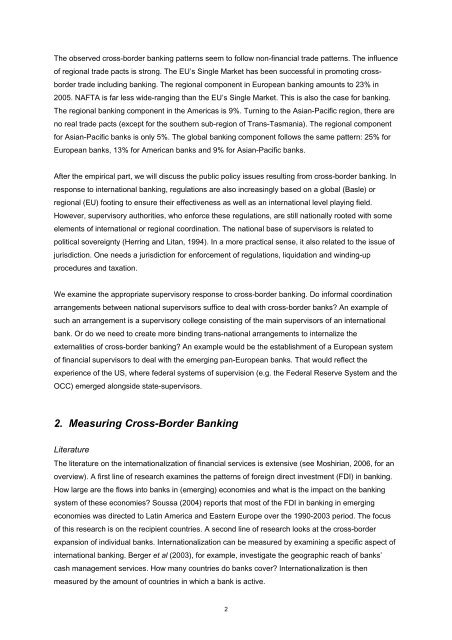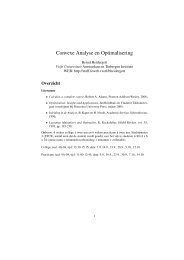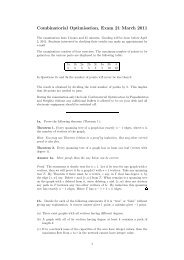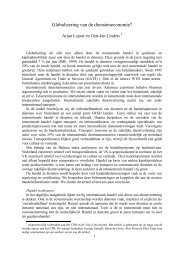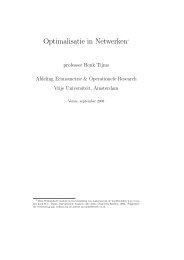Current State of Cross-Border Banking - Vrije Universiteit Amsterdam
Current State of Cross-Border Banking - Vrije Universiteit Amsterdam
Current State of Cross-Border Banking - Vrije Universiteit Amsterdam
You also want an ePaper? Increase the reach of your titles
YUMPU automatically turns print PDFs into web optimized ePapers that Google loves.
The observed cross-border banking patterns seem to follow non-financial trade patterns. The influence<br />
<strong>of</strong> regional trade pacts is strong. The EU’s Single Market has been successful in promoting crossborder<br />
trade including banking. The regional component in European banking amounts to 23% in<br />
2005. NAFTA is far less wide-ranging than the EU’s Single Market. This is also the case for banking.<br />
The regional banking component in the Americas is 9%. Turning to the Asian-Pacific region, there are<br />
no real trade pacts (except for the southern sub-region <strong>of</strong> Trans-Tasmania). The regional component<br />
for Asian-Pacific banks is only 5%. The global banking component follows the same pattern: 25% for<br />
European banks, 13% for American banks and 9% for Asian-Pacific banks.<br />
After the empirical part, we will discuss the public policy issues resulting from cross-border banking. In<br />
response to international banking, regulations are also increasingly based on a global (Basle) or<br />
regional (EU) footing to ensure their effectiveness as well as an international level playing field.<br />
However, supervisory authorities, who enforce these regulations, are still nationally rooted with some<br />
elements <strong>of</strong> international or regional coordination. The national base <strong>of</strong> supervisors is related to<br />
political sovereignty (Herring and Litan, 1994). In a more practical sense, it also related to the issue <strong>of</strong><br />
jurisdiction. One needs a jurisdiction for enforcement <strong>of</strong> regulations, liquidation and winding-up<br />
procedures and taxation.<br />
We examine the appropriate supervisory response to cross-border banking. Do informal coordination<br />
arrangements between national supervisors suffice to deal with cross-border banks? An example <strong>of</strong><br />
such an arrangement is a supervisory college consisting <strong>of</strong> the main supervisors <strong>of</strong> an international<br />
bank. Or do we need to create more binding trans-national arrangements to internalize the<br />
externalities <strong>of</strong> cross-border banking? An example would be the establishment <strong>of</strong> a European system<br />
<strong>of</strong> financial supervisors to deal with the emerging pan-European banks. That would reflect the<br />
experience <strong>of</strong> the US, where federal systems <strong>of</strong> supervision (e.g. the Federal Reserve System and the<br />
OCC) emerged alongside state-supervisors.<br />
2. Measuring <strong>Cross</strong>-<strong>Border</strong> <strong>Banking</strong><br />
Literature<br />
The literature on the internationalization <strong>of</strong> financial services is extensive (see Moshirian, 2006, for an<br />
overview). A first line <strong>of</strong> research examines the patterns <strong>of</strong> foreign direct investment (FDI) in banking.<br />
How large are the flows into banks in (emerging) economies and what is the impact on the banking<br />
system <strong>of</strong> these economies? Soussa (2004) reports that most <strong>of</strong> the FDI in banking in emerging<br />
economies was directed to Latin America and Eastern Europe over the 1990-2003 period. The focus<br />
<strong>of</strong> this research is on the recipient countries. A second line <strong>of</strong> research looks at the cross-border<br />
expansion <strong>of</strong> individual banks. Internationalization can be measured by examining a specific aspect <strong>of</strong><br />
international banking. Berger et al (2003), for example, investigate the geographic reach <strong>of</strong> banks’<br />
cash management services. How many countries do banks cover? Internationalization is then<br />
measured by the amount <strong>of</strong> countries in which a bank is active.<br />
2


